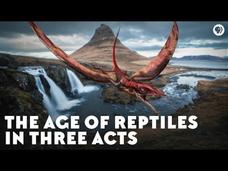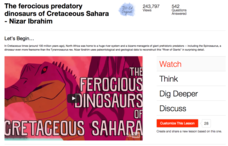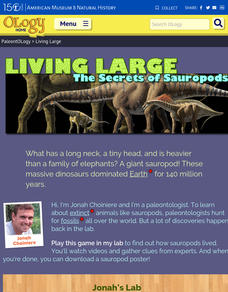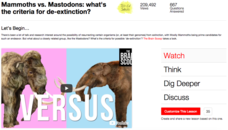Science360
DRILLING INTO THE JURASSIC IN NEW JERSEY
One hour from New York City, where the suburbs of New Jersey give way to farms, a team of scientists are drilling for ancient rocks on the edge of a cornfield. The rocks hold clues about what the earth was like about 201 million years...
Wonderscape
Science Kids: The Sixth Mass Extinction
Learn all about mass extinctions, including the history of Earth’s five major mass extinctions, as well as the conditions of today’s human-caused sixth extinction, which is the loss of animals from the planet. Understand the history of...
Mazz Media
Biodiversity
This live-action video program is about the word biodiversity. The program is designed to reinforce and support a student's comprehension and retention of the word biodiversity through use of video footage, photographs, diagrams and...
Mazz Media
Biodiversity
In this live-action program viewers will learn that biodiversity refers to the variety and variability of all living organisms and the different ecological complexes in which they exist. Students will come to understand that the word...
FuseSchool
Extinction of Species
When a plant or animal species that once lived stops existing entirely, we say that that species has become extinct. Why do certain species of plants and animals sometimes become extinct? According to the theory of evolution, individuals...
PBS
The Age of Reptiles in Three Acts
Reptiles survived the largest extinction event on the planet and then they grew into the most dominant class of the Mesozoic Era. They quickly evolved into giants on land, sea, and air. In an episode of the PBS Eons series viewers learn...
PBS
Why Triassic Animals Were Just the Weirdest
Normally when two species look similar, they are closely related. However, this doesn't seem to apply to the Triassic animals. Learn why these familiar looking animals are not actually related to today's animals. Viewers come to...
Howard Hughes Medical Institute
The Day the Mesozoic Died
Solve the ultimate who dunnit mystery: the death of the dinosaurs. Viewers watch an engaging video that describes how the asteroid impact hypothesis came to fruition and the evidence supporting it. The video also explains how life...
TED-Ed
Why Do We Harvest Horseshoe Crab Blood?
If you've ever had an injection, the horseshoe crab protects you from infection! Young marine biologists discover how scientists use the unique physiology of the horseshoe crab in medicine with a thought-provoking video. The narrator...
Crash Course
Why the Evolutionary Epic Matters: Crash Course Big History #203
Imagine a world where the only animals roaming the earth are domesticated. One day, we might not have to imagine the scenario of no wild animals—and that day approaches faster than predicted. A video explains the evolution from...
TED-Ed
The Ferocious Predatory Dinosaurs of Cretaceous Sahara
What's not to love about dinosaurs? Lucky for us humans, we can love to learn about them from 100 million years away, especially a group of extra large predatory dinosaurs from the Cretaceous period. Watch a descriptive video that...
Howard Hughes Medical Institute
The Day the Mesozoic Died
A dynamic, three-part feature explores what caused mass extinction of the dinosaurs at the end of the Cretaceous period. Computer animations, interviews, and on-site footage from around the world divulge evidence that it was the K-T...
American Museum of Natural History
Living Large
Get to know all about sauropods from a paleontologist, Jonah. Following an introductory video, scholars choose from five fossils to learn more about. Each fossil begins with a video, provides information from several different...
PBS
Why Megalodon (Definitely) Went Extinct
From the top of the food chain to extinction, follow the life of the megalodon! An episode in the PBS Eon series describes the evolution of the ancient species and its eventual extinction. The narrator discusses the fossil evidence and...
PBS
From the Cambrian Explosion to the Great Dying
Life before the dinosaurs was pretty amazing—and very fragile! Discover what Earth was like for Cambrian creatures, from the smallest ocean-dwellers to the first land animals. A video from an extensive biology playlist explores how early...
PBS
The Whole Saga of the Supercontinents
See the world as it was—and also how it will be! A riveting video from a vast biology and earth science playlist takes viewers back in time to see how supercontinents formed, broke apart, and formed again. The resource includes a sneak...
PBS
The Last Time the Globe Warmed
Global warming ... greenhouse gases ... climate change ... sounds familiar, right? What about palm trees in Wyoming, or swimming in the sea near Antarctica? Science scholars discover the unbearable conditions Earth experienced during its...
PBS
The Trouble With Trilobites
Trilobites survived on Earth for longer than mammals have, so what was their secret? From their evolution to diversity, they survived multiple large changes in the environment—and even flourished. Then, in the matter of less than a...
FuseSchool
Extinction of Species
Extinction: i's not just for dinosaurs! Young ecologists examine the alarming facts about the causes of mass extinctions by watching this engaging Fuse School Evolution video. Topics include previous extinction events, living fossils,...
Crash Course
The Evolutionary Epic: Crash Course Big History #5
In the timeline of history, Stegosaurus and Tyrannosaurus rex lived further apart from each other than Tyrannosaurus rex and humans. The fifth Crash Course-Big History video in a series of 16 introduces the concept of evolution. It...
MinuteEarth
The Deadliest Ice Age Ever
Will all species follow the trilobite down the road to extinction? Discover the changing conditions on ancient Earth that led to both population explosions and mass extinctions with a video presentation. The narrator shows examples...
MinuteEarth
How Many Mass Extinctions Have There Been?
Everyone knows about the extinction of the dinosaurs, but what other mass extinctions have happened? The video explains how scientists define mass extinctions. It offers insight into the debate about the number of mass extinctions as well.
TED-Ed
Mammoths vs. Mastodons: What's the Criteria for De-Extinction?
If you could, would you bring back mammoths or mastodons? What about resurrecting other species? Viewers consider some of the ethical and practical considerations involved in de-extinction.
SciShow
Mass Extinctions
99 percent of the species that have ever lived on this planet are extinct. The best way to understand when another extinction could happen is to study the previous five mass extinctions. The video discusses each one, the cause, the...


















